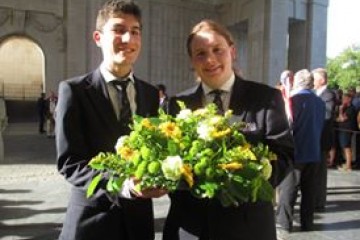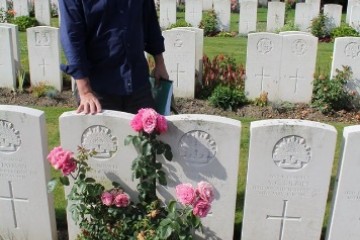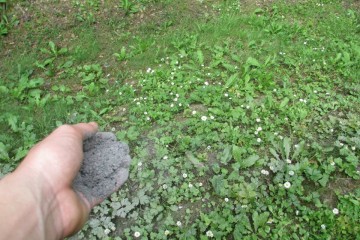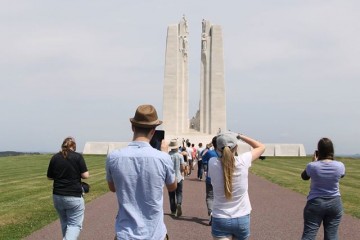Jacob Gamble Tour Report and Video
The medieval fortification around Ypres:Ypres (now called Ieper) is an ancient city located in the Flemish province of West Flanders, Belgium. In October 1914, French and British soldiers arrived in the town to put up a defence and to block the route for the German Army through Ypres to the ports on the French and Belgian coast. Many thousands of Allied troops died to maintain the Allies' possession of this place; and the town was almost completely destroyed by the end of 1918. The town was reconstructed during the 1920's and 1930's.
Image source: PAMS 2016 photo collection
Premier's Anzac Memorial Scholarship 2016
Tour Report
From Paris to Passchendaele: an adventure of a lifetime for 24 teens
During the July school holidays of 2016, 24 scholars in Years 10 and 11 from across NSW embarked on the Premier’s ANZAC Memorial Scholarship. The trip saw many of the scholars reconnect with the ANZAC spirit and learn about the tragedy of World War 1 that became a major part of Australia’s history.
The Department of Veteran’s Affairs offered this fully expense paid trip to commemorate the centenary of the participation of the ANZACs in World War 1. Three teachers, a historian, a tour guide and representatives from the Department and the RSL accompanied the students as they visited sites along the Western Front in France and Belgium.
The orientation day at the Hyde Park ANZAC Memorial in Sydney saw the students acquaint themselves with each other before they met the French Consular General, participated in a star throwing ceremony, collected the ashes of an unknown soldier and said goodbye to their families at the farewell ceremony.
“I felt honoured to be able to accept something that holds so much significance to our soldiers of World War 1,” said Lauren Berwick from Wollongong, who was given the role of formally accepting the ashes.
After thirty hours of flying, the group arrived in Paris for two days of sightseeing. They visited prominent sites including the Eiffel Tower, the Louvre, Les Invalides, the Palace of Versailles, Notre Dame and the famous church Basilica de Sacre Creur. Afternoon tea was shared with the Australian Ambassador to France and the Governor of NSW at the Ambassador’s house. The Ambassador was given the book “The First World War in Photographs”.
“It was nerve racking, but it felt right to be giving a symbol of unity through pictures of a war that both side were heavily involved in,” stated Jim Skinner from Warialda, who presented the Ambassador with the book.
The next ten days were spent travelling along the French countryside to a vast range of war memorials, museums and cemeteries, where the students were immersed in the history of the ANZACs. Historian Brad Minera guided the group through many of these sites, recounting personal stories of Australian soldiers and sharing his extensive knowledge of Australia’s participation in WW1. This was both an insightful and an emotional experience, as scholars were able to connect with the soldiers they were assigned to research as well as relatives lost in war.
The group visited sites from the prominent battles of Ypres, the Somme, Fromelles and Pozieres campaigns. A highlight was visiting the Menin Gate in Belgium, a grand structure in which the names of all missing soldiers from the Battle of Ypres are inscribed on the walls. Here the group attended the Last Post Ceremony where five students laid wreathes, including myself. While it was an emotional and eye-opening experience for everyone, Isabel Gahan from Young held a special connection to the monument.
“My great grandfather marched along the road, over which it stands, a century ago before battle,” she remarked full of mixed emotions, “it was certainly a moving experience.”
Many other scholars on the tour also held personal connections to the war. Antoine Van Overbeek from Grafton was the great, great, great grandson of the first Indigenous man to fight for Australia. He described the experience of walking the battlefields his relative had fought on as “saddening” but “something that will stay with me for a while”. Mitchell Price from Sydney had multiple relations who fought in WW1 and WW2.
“I felt incredibly honoured to be standing on the battlefields that they fought on,” Mitchell stated in reflection.
All scholars were required to research an assigned soldier prior to the trip, allowing them to follow in the footsteps of a person who lived through the tragedy of WW1. I researched a gentleman called Private Richard Brady, an Australian soldier who fought with the 10th Battalion of the Canadian Infantry at the Battle of Vimy Ridge. Sadly, he died on the 1st day of battle, killed instantly by shell fire, aged 24 years. It was an emotional experience being able to hold a copy of the papers he wrote on to enlist, with the knowledge that he once lived a normal life before being killed in war. Visiting the Battle site of Vimy Ridge and reflecting on Richard Brady’s tragic death made me realise the importance of recognising and remembering the sacrifice given by both known and unknown soldiers.
As Jeff O’Brien, a representative of the RSL, said, “It’s about the stories that we don’t hear, that we should remember.”
Scholars were given the opportunity to remember the sacrifice of the soldiers during centenary commemorations at Fromelles and Pozieres. The Fromelles centenary incorporated the unveiling of six soldiers that were recently recovered and identified, an emotional experience for the families that took part and the audience that looked on. Emma Stanton from Sydney, who had multiple relatives that fought in WW1, described it as “amazing to be part of something remembering the sacrifice of my ancestors”.
Pozieres was a remarkable ceremony in which diary extracts containing the stories of multiple soldiers were read out. Isabel Gahan and Patrick Doyle laid wreathes on behalf of the group.
“It was an incredibly poignant experience; one that I will treasure for the rest of my life,” Isabel said.
In addition to the formal public ceremonies of Pozieres and Fromelles, the group held their own private ceremonies in remembrance. This included a ceremony in which Noah McMillan, Nikita Papastamatis and Elizabeth Reid recited poems written by soldiers of the war before scholars and teachers laid the ashes of an unknown soldier to rest at a battle site in Belgium.
“Laying the ashes to rest felt really rewarding,” Ashley Naylor from Forster stated, “it was a beautiful feeling knowing that we finally brought the soldier back to where his fellow men lay.”
The trip was an incredible experience that opened my eyes to how profound Australia’s involvement in WW1 actually was. While my knowledge of the battles of WW1 has been substantially enhanced, I have grown a much larger admiration and appreciation of the ANZACs than I previously held. At the end of WW1, Australia made a promise to always remember the hardships, the courage, and the loyalty exhibited by the ANZACs.
I will remain committed to keeping that promise, remembering the sacrifices made by millions of soldiers just like Private Richard Brady, who gave their lives so we could enjoy the freedoms we have today.
Lest we forget.




